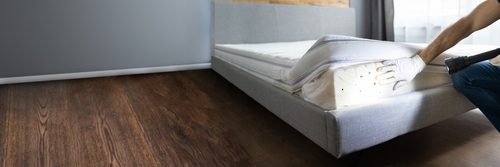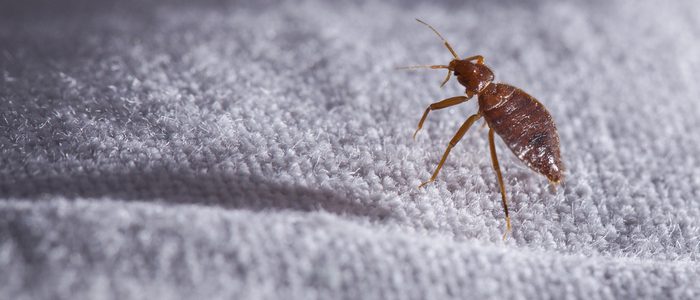A bed bug problem can turn a peaceful home into a source of stress and discomfort. These tiny pests are experts at hiding and can quickly spread from room to room, making them difficult to get rid of without professional help. Gregory Pest Solutions provides thorough, discreet, and efficient bed bug pest control services designed to tackle the issue at its source and help restore comfort to your home.
Why You Need a Professional Bed Bug Exterminator
Tackling bed bugs on your own may seem like a quick fix, but these pests are resilient and multiply fast. A single missed cluster of eggs or a few hidden bugs can result in a fresh infestation within weeks. DIY sprays and store-bought products rarely reach the deep cracks and narrow seams where bed bugs hide. They also don’t stay active long enough to target eggs that hatch days later.
Hire a trained bed bug exterminator and they will bring experience and specialized equipment to the job. At Gregory Pest Solutions, our team knows how to find the bugs others miss. We approach bed bug treatment methodically, starting with a detailed inspection and moving forward with a tailored plan for each home.
The benefit of hiring a professional means that the l treatment is not only more effective, but it can also be safer than DIY. Our methods are chosen with your family and pets in mind. We aim to minimize disruption while still delivering results.
Where Do Bed Bugs Come From?
The simple answer to how you get bed bugs is that you picked them up somewhere. People who travel are more susceptible as bed bugs are common in hotels, airports, and other hubs. They hitch a ride on clothing or luggage and then multiply once they safely establish themselves in your home.
Bed bugs re-emerged as a major pest problem in the mid-1990s after nearly disappearing for decades prior. Now bed bugs are back, and they’re back with a vengeance. Bed bugs have spread across the US, infecting nearly every city, suburb, and town. Today, they’re one of the most common pests homeowners call experts about every day.
Bed bugs don’t spread disease, but they do (infamously) feed on human blood. They bite you in your sleep to get the protein-rich nutrients they need to produce eggs. These bed-infesting pests spread and entrench themselves in homes very easily and are hard to get rid of without professional help. If you suspect you have an infestation, we recommend getting in touch as soon as possible. Professional treatments are the only sure way to keep bed bugs from continuing to spread through your home and bed.
How to Tell if You Have Bed Bugs
These reddish-brown, oval-shaped insects can easily go undetected until an infestation becomes severe. Recognizing the early signs of a bed bug problem is crucial for prompt intervention. Common hiding spots include mattresses, baseboards, furniture, and clothing. They typically bite at night, leaving itchy welts on exposed skin.
Signs to Look Out For
- Bite Marks: Small, red, itchy welts often appearing in lines or clusters on exposed skin
- Bloodstains: Tiny spots on bedding or clothing from crushed bugs or their feeding
- Fecal Spots: Dark, rust-colored excrement marks on mattresses, box springs, or bed frames
- Shedding Skins: Translucent remnants left behind as nymphs mature
- Musty Odor: A sweet, musty smell in heavily infested areas

What to Expect During Bed Bug Treatment
If you suspect bed bugs in your property, acting quickly is crucial. Gregory Pest Solutions can offer you a structured process to ensure we fully identify and eliminate the infestation. From the initial inspection to final treatment, we aim to make the process as smooth and stress-free as possible for you.
Our technicians take the following steps for each call:
- Inspection: We thoroughly examine your property to identify all potential bed bug hiding places.
- Implementation: We develop and execute a customized plan tailored to your specific bed bug issue.
- Maintenance: We provide follow-up services so your infestation stays gone.
If you have questions or suspect an infestation, our team is here to help.
Gregory Pest Solutions’s Expert Treatments
There are two steps to Gregory’s smarter, effective bed bug control: finding the bugs and wiping them out. Each of these parts is essential: if we don’t both find and eliminate every single bug, the infestation could start again. Luckily, Gregory has proven Smarter Solutions for both aspects of treatment. We find your entire infestation and make sure to wipe it out completely. Here’s how we do it:
Bed Bug-sniffing Dog Identification
Do bed bugs have a smell? They do, and Gregory trains bed bug-detection dogs to locate infestations by sniffing out his unique odor. Our dogs are specially trained to sniff out bed bugs at every stage of development. They don’t just find adult bed bugs; they find the eggs and larvae bed bug infestations create, too.
Using our canine unit, we can locate every bed bug hideout throughout your home. Bed bugs aren’t always just in your bed; we know how to find bed bugs in your carpet, headboard, closet, and anywhere else they may be hiding. Once we’ve identified where bed bugs are hiding in your home, we can begin wiping them out.
Thermal Remediation® Heat Treatment
Does heat kill bed bugs? Yes, and Thermal Remediation heat treatment is the most effective, least intrusive, and most environmentally-friendly way to combat bed bugs. Our experts subject each of the treatment areas identified in step 1 to concentrated heat treatments of 120° F or higher. We circulate this hot air using fans and monitor the process for four hours of application. We may also apply residual insecticides into cracks and crevices to eliminate bed bugs that might elude the heat. After treatment, we’ll conduct a final follow-up inspection to check that all bed bugs were eliminated successfully.
Thermal remediation is effective because applied 120° F heat kills bed bugs at every stage of development. We can completely eliminate bed bug eggs, larvae, and adults using one process. Residual pesticides serve to eliminate stragglers in hard-to-reach areas unobtrusively. With heat remediation, you don’t have to worry about infestations “reviving” because we get the eggs, too. Overall, thermal remediation is the Smarter Solution to residential bed bug infestation problems.
Thermal Remediation® and related logo is a trademark owned by TEMP-AIR, Inc. and is used by permission.
Bed Bug Pest Control Tips for Homeowners
While professional bed bug pest control is the most effective way to manage an infestation, there are also steps you can take to reduce the risk of bringing bed bugs into your home.
When you travel, inspect hotel rooms. Check the mattress seams, headboard, and furniture before unpacking for anything that may resemble bloodstains and fecal spots. Avoid placing your luggage on the bed or floor, and use luggage racks to store your suitcase off the ground. When you return home, wash and dry your clothes on high heat, even if you didn’t wear them.
Be cautious with second-hand furniture. If you plan to bring used items into your home, examine them closely for signs of bed bugs. It’s safest to avoid bringing in used mattresses, box springs, or upholstered items unless they’ve been professionally cleaned.
Reducing clutter can also help. Bed bugs love hiding in tight, undisturbed spaces. By keeping areas around your bed and furniture clear, you reduce potential hiding places and make inspections easier.
South Carolina‘s Bed Bug Exterminators
At Gregory Pest Solutions, we’ve been helping families across South Carolina with reliable bed bug pest control for decades. Our local technicians understand the unique needs of homeowners in this region and bring experience and care to every job.
Whether you’ve spotted early signs of bed bugs or are dealing with a widespread bed bug problem, we’re here to help. We provide detailed inspections, effective bed bug treatment, and follow-up support to ensure the pest issue you have in your home is fully addressed.
Contact us today or schedule a professional inspection. We’ll help you take the next step toward a more comfortable, protected home.

